Tokyo is often referred to and thought of as a city, but is
officially known and governed as a "metropolitan prefecture", which
differs from and combines elements of both a city and a prefecture; a
characteristic unique to Tokyo. The Tokyo metropolitan government
administers the 23 Special Wards of Tokyo
(each governed as an individual city), which cover the area that was
formerly the City of Tokyo before it merged and became the subsequent
metropolitan prefecture in 1943. The metropolitan government also
administers 39 municipalities
in the western part of the prefecture and the two outlying island
chains. The population of the special wards is over 9 million people,
with the total population of the prefecture exceeding 13 million. The
prefecture is part of the world's most populous metropolitan area with upwards of 37.8 million people and the world's largest urban agglomeration economy. The city hosts 51 of the Fortune Global 500 companies, the highest number of any city in the world.[9] Tokyo ranked third in the International Financial Centres Development IndexEdit. The city is also home to various television networks like Fuji TV, Tokyo MX, TV Tokyo, TV Asahi, Nippon Television and the Tokyo Broadcasting System.
Tokyo ranked third in the Global Economic Power Index and fourth in the Global Cities Index. The city is considered an alpha+ world city—as listed by the GaWC's 2008 inventory[10]—and in 2014, Tokyo was ranked first in the "Best overall experience" category of TripAdvisor's World City Survey (the city also ranked first in the following categories: "Helpfulness of locals", "Nightlife", "Shopping", "Local public transportation" and "Cleanliness of streets").[11] In 2013, Tokyo was named the third most expensive city for expatriates, according to the Mercer consulting firm,[12] and the world's most expensive city, according to the Economist Intelligence Unit's cost-of-living survey.[13] In 2015 Tokyo was named the Most Liveable City in the world by the magazine Monocle.[14] The Michelin Guide has awarded Tokyo by far the most Michelin stars of any city in the world.[15][16] Tokyo ranked first in the world in the Safe Cities Index. [17]
Central Tokyo, like Osaka, has been designed since about 1900 to be centered on major railway stations in a high-density fashion, so suburban railways were built relatively cheaply at street level and with their own right-of-way. This differs from many cities in the United States that are low-density and automobile-centric. Though expressways have been built in Tokyo, the basic design has not changed.
Tokyo went on to suffer two major catastrophes in the 20th century; the 1923 Great Kantō earthquake, which left 140,000 dead or missing,[30] and World War II.
World War II wrought widespread destruction of most of the city due to the persistent Allied air raids on Japan and the use of incendiary bombs. The bombing of Tokyo in 1944 and 1945 is estimated to have killed between 75,000 and 200,000 civilians and left more than half of the city destroyed.[31] The deadliest night of the war came on March 9–10, 1945, as nearly 700,000 incendiary bombs rained on the eastern half of the city, mainly in heavily residential wards. Two-fifths of the city was completely burned, more than 276,000 buildings were demolished, 100,000 civilians were killed, and 110,000 more were injured.[32][33] Between 1940 and 1945, the population of Japan's capital city dwindled from 6,700,000 to less than 2,800,000, with the majority of those who lost their lives living in "ramshackle, makeshift huts".[34]
After the war, Tokyo was completely rebuilt, and was showcased to the world during the 1964 Summer Olympics. The 1970s brought new high-rise developments such as Sunshine 60, a new and controversial[35] airport at Narita in 1978 (some distance outside city limits), and a population increase to about 11 million (in the metropolitan area).
Tokyo's subway and commuter rail network became one of the busiest in the world[36] as more and more people moved to the area. In the 1980s, real estate prices skyrocketed during a real estate and debt bubble. The bubble burst in the early 1990s, and many companies, banks, and individuals were caught with mortgage backed debts while real estate was shrinking in value. A major recession followed, making the 1990s Japan's "Lost Decade"[37] from which it is now slowly recovering.
Tokyo still sees new urban developments on large lots of less profitable land. Recent projects include Ebisu Garden Place, Tennozu Isle, Shiodome, Roppongi Hills, Shinagawa (now also a Shinkansen station), and the Marunouchi side of Tokyo Station. Buildings of significance are demolished for more up-to-date shopping facilities such as Omotesando Hills.
Land reclamation projects in Tokyo have also been going on for centuries. The most prominent is the Odaiba area, now a major shopping and entertainment center. Various plans have been proposed[38] for transferring national government functions from Tokyo to secondary capitals in other regions of Japan, in order to slow down rapid development in Tokyo and revitalize economically lagging areas of the country. These plans have been controversial[39] within Japan and have yet to be realized.
The 2011 Tōhoku earthquake and tsunami that devastated much of the northeastern coast of Honshu was felt in Tokyo. However, due to Tokyo's earthquake-resistant infrastructure, damage in Tokyo was very minor compared to areas directly hit by the tsunami,[40] although activity in the city was largely halted.[41] The subsequent nuclear crisis caused by the tsunami has also largely left Tokyo unaffected, despite occasional spikes in radiation levels.[42][43]
On September 7, 2013, the IOC selected Tokyo to host the 2020 Summer Olympics. Tokyo will be the first Asian city to host the Olympic Games twice.[44]
Also within the administrative boundaries of Tokyo Metropolis are two island chains in the Pacific Ocean directly south: the Izu Islands, and the Ogasawara Islands, which stretch more than 1,000 km (620 mi) away from the mainland. Because of these islands and the mountainous regions to the west, Tokyo's overall population density figures far underrepresent the real figures for the urban and suburban regions of Tokyo.
Under Japanese law, Tokyo is designated as a to (都), translated as metropolis.[46] Its administrative structure is similar to that of Japan's other prefectures. The 23 special wards (特別区 -ku), which until 1943 constituted the city of Tokyo, are now separate, self-governing municipalities, each having a mayor, a council, and the status of a city.
In addition to these 23 special wards, Tokyo also includes 26 more cities (市 -shi), five towns (町 -chō or machi), and eight villages (村 -son or -mura), each of which has a local government. The Tokyo Metropolitan Government, which administers the whole metropolis, is headed by a publicly elected governor and metropolitan assembly. Its headquarters are located in Shinjuku Ward.
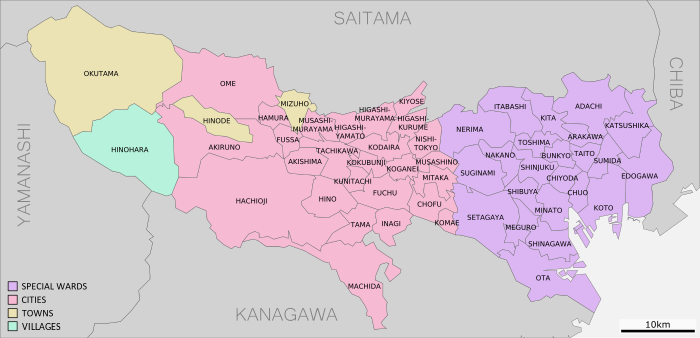
The wards differ from other cities in having a unique administrative relationship with the prefectural government. Certain municipal functions, such as waterworks, sewerage, and fire-fighting, are handled by the Tokyo Metropolitan Government. To pay for the added administrative costs, the prefecture collects municipal taxes, which would usually be levied by the city.[47]
Ueno Park is well known for its museums: Tokyo National Museum, National Museum of Nature and Science, Shitamachi Museum and National Museum for Western Art, among others. There are also art works and statues at several places in the park. There is also a zoo in the park, and the park is a popular destination to view cherry blossoms.
Tokyo is a major international finance center,[78] houses the headquarters of several of the world's largest investment banks and insurance companies, and serves as a hub for Japan's transportation, publishing, electronics and broadcasting industries. During the centralised growth of Japan's economy following World War II, many large firms moved their headquarters from cities such as Osaka (the historical commercial capital) to Tokyo, in an attempt to take advantage of better access to the government. This trend has begun to slow due to ongoing population growth in Tokyo and the high cost of living there.
Tokyo was rated by the Economist Intelligence Unit as the most expensive (highest cost-of-living) city in the world for 14 years in a row ending in 2006.[79]
Tokyo has been described as one of the three "command centers" for the world economy, along with New York City and London.[80] The Tokyo Stock Exchange is Japan's largest stock exchange, and third largest in the world by market capitalization and fourth largest by share turnover. In 1990 at the end of the Japanese asset price bubble, it accounted for more than 60% of the world stock market value.[81] Tokyo had 8,460 ha (20,900 acres) of agricultural land as of 2003,[82] according to the Ministry of Agriculture, Forestry and Fisheries, placing it last among the nation's prefectures. The farmland is concentrated in Western Tokyo. Perishables such as vegetables, fruits, and flowers can be conveniently shipped to the markets in the eastern part of the prefecture. Komatsuna and spinach are the most important vegetables; as of 2000, Tokyo supplied 32.5% of the komatsuna sold at its central produce market.
With 36% of its area covered by forest, Tokyo has extensive growths of cryptomeria and Japanese cypress, especially in the mountainous western communities of Akiruno, Ōme, Okutama, Hachiōji, Hinode, and Hinohara. Decreases in the price of timber, increases in the cost of production, and advancing old age among the forestry population have resulted in a decline in Tokyo's output. In addition, pollen, especially from cryptomeria, is a major allergen for the nearby population centers. Tokyo Bay was once a major source of fish.[citation needed] Currently, most of Tokyo's fish production comes from the outer islands, such as Izu Ōshima and Hachijōjima. Skipjack tuna, nori, and aji are among the ocean products.[citation needed]
Tourism in Tokyo is also a contributor to the economy. In 2006, 4.81 million foreigners and 420 million Japanese visits to Tokyo were made; the economic value of these visits totaled 9.4 trillion yen according to the government of Tokyo. Many tourists visit the various downtowns, stores, and entertainment districts throughout the neighbourhoods of the special wards of Tokyo; particularly school children on class trips, a visit to Tokyo Tower is de rigueur. Cultural offerings include both omnipresent Japanese pop culture and associated districts such as Shibuya and Harajuku, subcultural attractions such as Studio Ghibli anime center, as well as museums like the Tokyo National Museum, which houses 37% of the country's artwork national treasures (87/233).
The Tsukiji Fish Market in central Tokyo is the biggest wholesale fish and seafood market in the world and also one of the largest wholesale food markets of any kind. The Tsukiji market holds strong to the traditions of its predecessor, the Nihombashi fish market, and serves some 50,000 buyers and sellers every day. Retailers, whole-sellers, auctioneers, and public citizens alike frequent the market, creating a unique microcosm of organized chaos that still continues to fuel the city and its food supply after over four centuries.[83]
Within Ōta, one of the 23 special wards, Haneda Airport offers domestic and international flights. Outside Tokyo, Narita International Airport, in Chiba Prefecture, is the major gateway for international travelers to Japan. Japan's flag carrier Japan Airlines, as well as All Nippon Airways, Delta Air Lines, and United Airlines all have a hub at this airport.
Various islands governed by Tokyo have their own airports. Hachijō-jima (Hachijojima Airport), Miyakejima (Miyakejima Airport), and Izu Ōshima (Oshima Airport) have services to Tokyo International and other airports.
Rail is the primary mode of transportation in Tokyo, which has the most extensive urban railway network in the world and an equally extensive network of surface lines. JR East operates Tokyo's largest railway network, including the Yamanote Line loop that circles the center of downtown Tokyo. Two different organisations operate the subway network: the private Tokyo Metro and the governmental Tokyo Metropolitan Bureau of Transportation. The metropolitan government and private carriers operate bus routes and one tram route. Local, regional, and national services are available, with major terminals at the giant railroad stations, including Tokyo, Shinagawa, and Shinjuku.
Expressways link the capital to other points in the Greater Tokyo area, the Kantō region, and the islands of Kyushu and Shikoku. In order to build them quickly before the 1964 Summer Olympics, most were constructed above existing roads.[85] Other transportation includes taxis operating in the special wards and the cities and towns. Also long-distance ferries serve the islands of Tokyo and carry passengers and cargo to domestic and foreign ports.
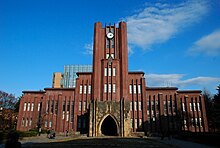 Tokyo has many universities, junior colleges, and vocational schools.
Many of Japan's most prestigious universities are in Tokyo, including University of Tokyo, Hitotsubashi University, Tokyo Institute of Technology, Waseda University, and Keio University.[86] Some of the biggest national universities in Tokyo are:
Tokyo has many universities, junior colleges, and vocational schools.
Many of Japan's most prestigious universities are in Tokyo, including University of Tokyo, Hitotsubashi University, Tokyo Institute of Technology, Waseda University, and Keio University.[86] Some of the biggest national universities in Tokyo are:
There are also a few universities well known for classes conducted in English and for the teaching of the Japanese language. They include:
For an extensive list, see List of universities in Tokyo.
Publicly run kindergartens, elementary schools (years 1 through 6), and Primary schools (7 through 9) are operated by local wards or municipal offices. Public Secondary schools in Tokyo are run by the Tokyo Metropolitan Government Board of Education and are called "Metropolitan High Schools". Tokyo also has many private schools from kindergarten through high school.
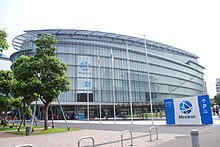 Tokyo has many museums. In Ueno Park, there is the Tokyo National Museum, the country's largest museum and specializing in traditional Japanese art; the National Museum of Western Art and Ueno Zoo. Other museums include the National Museum of Emerging Science and Innovation in Odaiba; the Edo-Tokyo Museum in Sumida, across the Sumida River from the center of Tokyo; the Nezu Museum in Aoyama; and the National Diet Library, National Archives, and the National Museum of Modern Art, which are near the Imperial Palace.
Tokyo has many museums. In Ueno Park, there is the Tokyo National Museum, the country's largest museum and specializing in traditional Japanese art; the National Museum of Western Art and Ueno Zoo. Other museums include the National Museum of Emerging Science and Innovation in Odaiba; the Edo-Tokyo Museum in Sumida, across the Sumida River from the center of Tokyo; the Nezu Museum in Aoyama; and the National Diet Library, National Archives, and the National Museum of Modern Art, which are near the Imperial Palace.
Tokyo has many theatres for performing arts. These include national and private theatres for traditional forms of Japanese drama. Noteworthy are the National Noh Theatre for noh and the Kabuki-za for kabuki.[87] Symphony orchestras and other musical organisations perform modern and traditional music. Tokyo also hosts modern Japanese and international pop and rock music at venues ranging in size from intimate clubs to internationally known arenas such as the Nippon Budokan.
 Many different festivals occur throughout Tokyo. Major events include the Sannō at Hie Shrine, the Sanja at Asakusa Shrine, and the biennial Kanda
Festivals. The last features a parade with elaborately decorated floats
and thousands of people. Annually on the last Saturday of July, an
enormous fireworks display over the Sumida River attracts over a million viewers. Once cherry blossoms bloom in spring, many residents gather in Ueno Park, Inokashira Park, and the Shinjuku Gyoen National Garden for picnics under the blossoms.
Many different festivals occur throughout Tokyo. Major events include the Sannō at Hie Shrine, the Sanja at Asakusa Shrine, and the biennial Kanda
Festivals. The last features a parade with elaborately decorated floats
and thousands of people. Annually on the last Saturday of July, an
enormous fireworks display over the Sumida River attracts over a million viewers. Once cherry blossoms bloom in spring, many residents gather in Ueno Park, Inokashira Park, and the Shinjuku Gyoen National Garden for picnics under the blossoms.
Harajuku, a neighbourhood in Shibuya, is known internationally for its youth style, fashion[88] and cosplay.
Cuisine in Tokyo is internationally acclaimed. In November 2007, Michelin released their first guide for fine dining in Tokyo, awarding 191 stars in total, or about twice as many as Tokyo's nearest competitor, Paris. Eight establishments were awarded the maximum of three stars (Paris has 10), 25 received two stars, and 117 earned one star. Of the eight top-rated restaurants, three offer traditional Japanese fine dining, two are sushi houses and three serve French cuisine.[89]
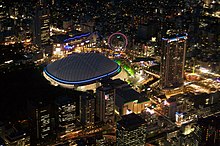

Tokyo hosted the 1964 Summer Olympics, thus becoming the first Asian city to host the Summer Games. The National Stadium, also known as the Olympic Stadium is host to a number of international sporting events. With a number of world-class sports venues, Tokyo often hosts national and international sporting events such as tennis tournaments, swim meets, marathons, rugby union and sevens rugby games, football, American football exhibition games, judo, and karate. Tokyo Metropolitan Gymnasium, in Sendagaya, Shibuya, is a large sports complex that includes swimming pools, training rooms, and a large indoor arena. According to Around the Rings, the gymnasium has played host to the October 2011 artistic gymnastics world championships, despite the International Gymnastics Federation's initial doubt in Tokyo's ability to host the championships following the March 11 tsunami.[90] Tokyo was selected to host the 2020 Summer Olympics on September 7, 2013.
 As the largest population center in Japan and the site of the
country's largest broadcasters and studios, Tokyo is frequently the
setting for many Japanese movies, television shows, animated series (anime), web comics, and comic books (manga). In the kaiju (monster movie) genre, landmarks of Tokyo are routinely destroyed by giant monsters such as Godzilla and Gamera.
As the largest population center in Japan and the site of the
country's largest broadcasters and studios, Tokyo is frequently the
setting for many Japanese movies, television shows, animated series (anime), web comics, and comic books (manga). In the kaiju (monster movie) genre, landmarks of Tokyo are routinely destroyed by giant monsters such as Godzilla and Gamera.
Some Hollywood directors have turned to Tokyo as a backdrop for movies set in Tokyo. Well-known postwar examples include Tokyo Joe, My Geisha, Tokyo Story and the James Bond film You Only Live Twice; well-known recent examples include Kill Bill, The Fast and the Furious: Tokyo Drift, Lost in Translation, Babel, and Inception.
Tokyo also contains numerous parks and gardens.There are four national parks in Tokyo Prefecture, including the Fuji-Hakone-Izu National Park, which includes all of the Izu Islands.Tokyo city
Tokyo ranked third in the Global Economic Power Index and fourth in the Global Cities Index. The city is considered an alpha+ world city—as listed by the GaWC's 2008 inventory[10]—and in 2014, Tokyo was ranked first in the "Best overall experience" category of TripAdvisor's World City Survey (the city also ranked first in the following categories: "Helpfulness of locals", "Nightlife", "Shopping", "Local public transportation" and "Cleanliness of streets").[11] In 2013, Tokyo was named the third most expensive city for expatriates, according to the Mercer consulting firm,[12] and the world's most expensive city, according to the Economist Intelligence Unit's cost-of-living survey.[13] In 2015 Tokyo was named the Most Liveable City in the world by the magazine Monocle.[14] The Michelin Guide has awarded Tokyo by far the most Michelin stars of any city in the world.[15][16] Tokyo ranked first in the world in the Safe Cities Index. [17]
History
Main article: History of Tokyo
Pre-1869 (Edo Period)
Tokyo was originally a small fishing village named Edo,[8] in what was formerly part of the old Musashi Province.[22] Edo was first fortified by the Edo clan, in the late twelfth century. In 1457, Ōta Dōkan built Edo Castle. In 1590, Tokugawa Ieyasu made Edo his base. When he became shogun in 1603, the town became the center of his nationwide military government. During the subsequent Edo period, Edo grew into one of the largest cities in the world with a population topping one million by the 18th century.[23] Edo became the de facto capital of Japan[24] even while the emperor lived in Kyoto, the imperial capital. During this time, the city enjoyed a prolonged period of peace known as the Pax Tokugawa, and in the presence of such peace, Edo adopted a stringent policy of seclusion, which helped to perpetuate the lack of any serious military threat to the city.[25] The absence of war-inflicted devastation allowed Edo to devote the majority of its resources to rebuilding in the wake of the consistent fires, earthquakes, and other devastating natural disasters that plagued the city. However, this prolonged period of seclusion came to an end with the arrival of American Commodore, Matthew C. Perry in 1853. Commodore Perry negotiated the opening of the ports of Shimoda and Hakodate, leading to an increase in the demand for new foreign goods and subsequently a severe rise in inflation.[26] Social unrest mounted in the wake of these higher prices and culminated in wide spread rebellions and demonstrations, especially in the form of the "smashing" of rice establishments.[27] Meanwhile, supporters of the Meiji Emperor leveraged the disruption that these widespread rebellious demonstrations were causing to further consolidate power by overthrowing the last Tokugawa shogun, Yoshinobu, in 1867.[28] After about 263 years, the Pax Tokugawa came to an end.1869–1943
Main articles: Tokyo City and Tokyo Prefecture
In 1869, the 17-year-old Emperor Meiji
moved to Edo, and in accordance the city was renamed Tokyo (meaning
Eastern Capital). Tokyo was already the nation's political and cultural
center,[29] and the emperor's residence made it a de facto imperial capital as well, with the former Edo Castle becoming the Imperial Palace. The city of Tokyo was officially established on 1 May 1889.Central Tokyo, like Osaka, has been designed since about 1900 to be centered on major railway stations in a high-density fashion, so suburban railways were built relatively cheaply at street level and with their own right-of-way. This differs from many cities in the United States that are low-density and automobile-centric. Though expressways have been built in Tokyo, the basic design has not changed.
Tokyo went on to suffer two major catastrophes in the 20th century; the 1923 Great Kantō earthquake, which left 140,000 dead or missing,[30] and World War II.
1943–present
Main article: Tokyo Metropolis
In 1943, the city of Tokyo merged with the "Metropolitan Prefecture" of Tokyo.World War II wrought widespread destruction of most of the city due to the persistent Allied air raids on Japan and the use of incendiary bombs. The bombing of Tokyo in 1944 and 1945 is estimated to have killed between 75,000 and 200,000 civilians and left more than half of the city destroyed.[31] The deadliest night of the war came on March 9–10, 1945, as nearly 700,000 incendiary bombs rained on the eastern half of the city, mainly in heavily residential wards. Two-fifths of the city was completely burned, more than 276,000 buildings were demolished, 100,000 civilians were killed, and 110,000 more were injured.[32][33] Between 1940 and 1945, the population of Japan's capital city dwindled from 6,700,000 to less than 2,800,000, with the majority of those who lost their lives living in "ramshackle, makeshift huts".[34]
After the war, Tokyo was completely rebuilt, and was showcased to the world during the 1964 Summer Olympics. The 1970s brought new high-rise developments such as Sunshine 60, a new and controversial[35] airport at Narita in 1978 (some distance outside city limits), and a population increase to about 11 million (in the metropolitan area).
Tokyo's subway and commuter rail network became one of the busiest in the world[36] as more and more people moved to the area. In the 1980s, real estate prices skyrocketed during a real estate and debt bubble. The bubble burst in the early 1990s, and many companies, banks, and individuals were caught with mortgage backed debts while real estate was shrinking in value. A major recession followed, making the 1990s Japan's "Lost Decade"[37] from which it is now slowly recovering.
Tokyo still sees new urban developments on large lots of less profitable land. Recent projects include Ebisu Garden Place, Tennozu Isle, Shiodome, Roppongi Hills, Shinagawa (now also a Shinkansen station), and the Marunouchi side of Tokyo Station. Buildings of significance are demolished for more up-to-date shopping facilities such as Omotesando Hills.
Land reclamation projects in Tokyo have also been going on for centuries. The most prominent is the Odaiba area, now a major shopping and entertainment center. Various plans have been proposed[38] for transferring national government functions from Tokyo to secondary capitals in other regions of Japan, in order to slow down rapid development in Tokyo and revitalize economically lagging areas of the country. These plans have been controversial[39] within Japan and have yet to be realized.
The 2011 Tōhoku earthquake and tsunami that devastated much of the northeastern coast of Honshu was felt in Tokyo. However, due to Tokyo's earthquake-resistant infrastructure, damage in Tokyo was very minor compared to areas directly hit by the tsunami,[40] although activity in the city was largely halted.[41] The subsequent nuclear crisis caused by the tsunami has also largely left Tokyo unaffected, despite occasional spikes in radiation levels.[42][43]
On September 7, 2013, the IOC selected Tokyo to host the 2020 Summer Olympics. Tokyo will be the first Asian city to host the Olympic Games twice.[44]
Geography and administrative divisions
Main articles: Tokyo Metropolitan Government and List of mergers in Tokyo
The mainland portion of Tokyo lies northwest of Tokyo Bay
and measures about 90 km (56 mi) east to west and 25 km (16 mi) north
to south. The average elevation in Tokyo is 40 m (131 ft).[45] Chiba Prefecture borders it to the east, Yamanashi to the west, Kanagawa to the south, and Saitama to the north. Mainland Tokyo is further subdivided into the special wards (occupying the eastern half) and the Tama area (多摩地域) stretching westwards.Also within the administrative boundaries of Tokyo Metropolis are two island chains in the Pacific Ocean directly south: the Izu Islands, and the Ogasawara Islands, which stretch more than 1,000 km (620 mi) away from the mainland. Because of these islands and the mountainous regions to the west, Tokyo's overall population density figures far underrepresent the real figures for the urban and suburban regions of Tokyo.
Under Japanese law, Tokyo is designated as a to (都), translated as metropolis.[46] Its administrative structure is similar to that of Japan's other prefectures. The 23 special wards (特別区 -ku), which until 1943 constituted the city of Tokyo, are now separate, self-governing municipalities, each having a mayor, a council, and the status of a city.
In addition to these 23 special wards, Tokyo also includes 26 more cities (市 -shi), five towns (町 -chō or machi), and eight villages (村 -son or -mura), each of which has a local government. The Tokyo Metropolitan Government, which administers the whole metropolis, is headed by a publicly elected governor and metropolitan assembly. Its headquarters are located in Shinjuku Ward.

Special wards
The special wards (特別区 tokubetsu-ku?) of Tokyo comprise the area formerly incorporated as Tokyo City. On July 1, 1943, Tokyo City was merged with Tokyo Prefecture (東京府 Tōkyō-fu?) forming the current "metropolitan prefecture". As a result, unlike other city wards in Japan, these wards are not conterminous with a larger incorporated city. While falling under the jurisdiction of Tokyo Metropolitan Government, each ward is also a borough with its own elected leader and council, like other cities of Japan. The special wards use the word "city" in their official English name (e.g. Chiyoda City).The wards differ from other cities in having a unique administrative relationship with the prefectural government. Certain municipal functions, such as waterworks, sewerage, and fire-fighting, are handled by the Tokyo Metropolitan Government. To pay for the added administrative costs, the prefecture collects municipal taxes, which would usually be levied by the city.[47]
National parks
As of March 31, 2008, 36% of the total land area of the prefecture was designated as Natural Parks (second only to Shiga Prefecture), namely the Chichibu Tama Kai, Fuji-Hakone-Izu, and Ogasawara National Parks (the last a UNESCO World Heritage Site); Meiji no Mori Takao Quasi-National Park; and Akikawa Kyūryō, Hamura Kusabana Kyūryō, Sayama, Takao Jinba, Takiyama, and Tama Kyūryō Prefectural Natural Parks.[51]Ueno Park is well known for its museums: Tokyo National Museum, National Museum of Nature and Science, Shitamachi Museum and National Museum for Western Art, among others. There are also art works and statues at several places in the park. There is also a zoo in the park, and the park is a popular destination to view cherry blossoms.
Seismicity
Tokyo was hit by powerful earthquakes in 1703, 1782, 1812, 1855, 1923, and 2011.[52][53] The 1923 earthquake, with an estimated magnitude of 8.3, killed 142,000 people. Tokyo is near the boundary of three plates.Climate
The former city of Tokyo and the majority of mainland Tokyo lie in the humid subtropical climate zone (Köppen climate classification Cfa),[54] with hot humid summers and generally mild winters with cool spells. The region, like much of Japan, experiences a one-month seasonal lag, with the warmest month being August, which averages 26.4 °C (79.5 °F), and the coolest month being January, averaging 5.2 °C (41.4 °F). The record low temperature is −9.2 °C (15.4 °F), and the record high is 39.5 °C (103.1 °F), though there was once an unofficial reading of 42.7 °C (108.9 °F) at the Primary School Station.[55] Annual rainfall averages nearly 1,530 millimetres (60.2 in), with a wetter summer and a drier winter. Snowfall is sporadic, but does occur almost annually.[56] Tokyo also often sees typhoons each year, though few are strong. The last one to hit was Fitow in 2007,[57][dubious ] while the wettest month since records began in 1876 has been October 2004 with 780 millimetres (30 in)[58] including 270.5 millimetres (10.6 in) on the ninth of that month.[59]Economy
Tokyo has the largest metropolitan economy in the world. According to a study conducted by PricewaterhouseCoopers, the Tokyo urban area (35 million people) had a total GDP of US$1.9 trillion in 2012 (at purchasing power parity), which topped that list. 51 of the companies listed on the Global 500 are based in Tokyo, almost twice that of the second-placed city (Paris).[77]Tokyo is a major international finance center,[78] houses the headquarters of several of the world's largest investment banks and insurance companies, and serves as a hub for Japan's transportation, publishing, electronics and broadcasting industries. During the centralised growth of Japan's economy following World War II, many large firms moved their headquarters from cities such as Osaka (the historical commercial capital) to Tokyo, in an attempt to take advantage of better access to the government. This trend has begun to slow due to ongoing population growth in Tokyo and the high cost of living there.
Tokyo was rated by the Economist Intelligence Unit as the most expensive (highest cost-of-living) city in the world for 14 years in a row ending in 2006.[79]
Tokyo has been described as one of the three "command centers" for the world economy, along with New York City and London.[80] The Tokyo Stock Exchange is Japan's largest stock exchange, and third largest in the world by market capitalization and fourth largest by share turnover. In 1990 at the end of the Japanese asset price bubble, it accounted for more than 60% of the world stock market value.[81] Tokyo had 8,460 ha (20,900 acres) of agricultural land as of 2003,[82] according to the Ministry of Agriculture, Forestry and Fisheries, placing it last among the nation's prefectures. The farmland is concentrated in Western Tokyo. Perishables such as vegetables, fruits, and flowers can be conveniently shipped to the markets in the eastern part of the prefecture. Komatsuna and spinach are the most important vegetables; as of 2000, Tokyo supplied 32.5% of the komatsuna sold at its central produce market.
With 36% of its area covered by forest, Tokyo has extensive growths of cryptomeria and Japanese cypress, especially in the mountainous western communities of Akiruno, Ōme, Okutama, Hachiōji, Hinode, and Hinohara. Decreases in the price of timber, increases in the cost of production, and advancing old age among the forestry population have resulted in a decline in Tokyo's output. In addition, pollen, especially from cryptomeria, is a major allergen for the nearby population centers. Tokyo Bay was once a major source of fish.[citation needed] Currently, most of Tokyo's fish production comes from the outer islands, such as Izu Ōshima and Hachijōjima. Skipjack tuna, nori, and aji are among the ocean products.[citation needed]
Tourism in Tokyo is also a contributor to the economy. In 2006, 4.81 million foreigners and 420 million Japanese visits to Tokyo were made; the economic value of these visits totaled 9.4 trillion yen according to the government of Tokyo. Many tourists visit the various downtowns, stores, and entertainment districts throughout the neighbourhoods of the special wards of Tokyo; particularly school children on class trips, a visit to Tokyo Tower is de rigueur. Cultural offerings include both omnipresent Japanese pop culture and associated districts such as Shibuya and Harajuku, subcultural attractions such as Studio Ghibli anime center, as well as museums like the Tokyo National Museum, which houses 37% of the country's artwork national treasures (87/233).
The Tsukiji Fish Market in central Tokyo is the biggest wholesale fish and seafood market in the world and also one of the largest wholesale food markets of any kind. The Tsukiji market holds strong to the traditions of its predecessor, the Nihombashi fish market, and serves some 50,000 buyers and sellers every day. Retailers, whole-sellers, auctioneers, and public citizens alike frequent the market, creating a unique microcosm of organized chaos that still continues to fuel the city and its food supply after over four centuries.[83]
Transportation
Main article: Transportation in Greater Tokyo
Tokyo, as the center of the Greater Tokyo Area,
is Japan's largest domestic and international hub for rail, ground, and
air transportation. Public transportation within Tokyo is dominated by
an extensive network of clean and efficient[84] trains and subways run by a variety of operators, with buses, monorails and trams playing a secondary feeder role.Within Ōta, one of the 23 special wards, Haneda Airport offers domestic and international flights. Outside Tokyo, Narita International Airport, in Chiba Prefecture, is the major gateway for international travelers to Japan. Japan's flag carrier Japan Airlines, as well as All Nippon Airways, Delta Air Lines, and United Airlines all have a hub at this airport.
Various islands governed by Tokyo have their own airports. Hachijō-jima (Hachijojima Airport), Miyakejima (Miyakejima Airport), and Izu Ōshima (Oshima Airport) have services to Tokyo International and other airports.
Rail is the primary mode of transportation in Tokyo, which has the most extensive urban railway network in the world and an equally extensive network of surface lines. JR East operates Tokyo's largest railway network, including the Yamanote Line loop that circles the center of downtown Tokyo. Two different organisations operate the subway network: the private Tokyo Metro and the governmental Tokyo Metropolitan Bureau of Transportation. The metropolitan government and private carriers operate bus routes and one tram route. Local, regional, and national services are available, with major terminals at the giant railroad stations, including Tokyo, Shinagawa, and Shinjuku.
Expressways link the capital to other points in the Greater Tokyo area, the Kantō region, and the islands of Kyushu and Shikoku. In order to build them quickly before the 1964 Summer Olympics, most were constructed above existing roads.[85] Other transportation includes taxis operating in the special wards and the cities and towns. Also long-distance ferries serve the islands of Tokyo and carry passengers and cargo to domestic and foreign ports.
Education
Main article: Education in Tokyo

University of Tokyo, Yasuda Auditorium
- Hitotsubashi University
- National Graduate Institute for Policy Studies
- Ochanomizu University
- Tokyo Gakugei University
- Tokyo Institute of Technology
- Tokyo Medical and Dental University
- Tokyo University of Agriculture and Technology
- Tokyo University of Foreign Studies
- Tokyo University of Marine Science and Technology
- Tokyo University of the Arts
- University of Electro-Communications
- University of Tokyo
There are also a few universities well known for classes conducted in English and for the teaching of the Japanese language. They include:
- Globis University Graduate School of Management
- International Christian University
- Sophia University
- Waseda University
For an extensive list, see List of universities in Tokyo.
Publicly run kindergartens, elementary schools (years 1 through 6), and Primary schools (7 through 9) are operated by local wards or municipal offices. Public Secondary schools in Tokyo are run by the Tokyo Metropolitan Government Board of Education and are called "Metropolitan High Schools". Tokyo also has many private schools from kindergarten through high school.
Culture

The National Museum of Emerging Science and Innovation also known as "Miraikan"
Tokyo has many theatres for performing arts. These include national and private theatres for traditional forms of Japanese drama. Noteworthy are the National Noh Theatre for noh and the Kabuki-za for kabuki.[87] Symphony orchestras and other musical organisations perform modern and traditional music. Tokyo also hosts modern Japanese and international pop and rock music at venues ranging in size from intimate clubs to internationally known arenas such as the Nippon Budokan.

The Sanja Festival in Asakusa
Harajuku, a neighbourhood in Shibuya, is known internationally for its youth style, fashion[88] and cosplay.
Cuisine in Tokyo is internationally acclaimed. In November 2007, Michelin released their first guide for fine dining in Tokyo, awarding 191 stars in total, or about twice as many as Tokyo's nearest competitor, Paris. Eight establishments were awarded the maximum of three stars (Paris has 10), 25 received two stars, and 117 earned one star. Of the eight top-rated restaurants, three offer traditional Japanese fine dining, two are sushi houses and three serve French cuisine.[89]
Sports

Tokyo Dome, the home stadium for the Yomiuri Giants

Ryōgoku Kokugikan sumo wrestling arena
Main article: Sports in Tokyo
Tokyo, with a diverse array of sports, is home to two professional baseball clubs, the Yomiuri Giants who play at the Tokyo Dome and Tokyo Yakult Swallows at Meiji-Jingu Stadium. The Japan Sumo Association is also headquartered in Tokyo at the Ryōgoku Kokugikan sumo arena where three official sumo tournaments are held annually (in January, May, and September). Football clubs in Tokyo include F.C. Tokyo and Tokyo Verdy 1969, both of which play at Ajinomoto Stadium in Chōfu.Tokyo hosted the 1964 Summer Olympics, thus becoming the first Asian city to host the Summer Games. The National Stadium, also known as the Olympic Stadium is host to a number of international sporting events. With a number of world-class sports venues, Tokyo often hosts national and international sporting events such as tennis tournaments, swim meets, marathons, rugby union and sevens rugby games, football, American football exhibition games, judo, and karate. Tokyo Metropolitan Gymnasium, in Sendagaya, Shibuya, is a large sports complex that includes swimming pools, training rooms, and a large indoor arena. According to Around the Rings, the gymnasium has played host to the October 2011 artistic gymnastics world championships, despite the International Gymnastics Federation's initial doubt in Tokyo's ability to host the championships following the March 11 tsunami.[90] Tokyo was selected to host the 2020 Summer Olympics on September 7, 2013.
In popular culture

Fuji TV headquarters
Some Hollywood directors have turned to Tokyo as a backdrop for movies set in Tokyo. Well-known postwar examples include Tokyo Joe, My Geisha, Tokyo Story and the James Bond film You Only Live Twice; well-known recent examples include Kill Bill, The Fast and the Furious: Tokyo Drift, Lost in Translation, Babel, and Inception.
Cityscape
Architecture in Tokyo has largely been shaped by Tokyo's history. Twice in recent history has the metropolis been left in ruins: first in the 1923 Great Kantō earthquake and later after extensive firebombing in World War II.[91] Because of this, Tokyo's urban landscape consists mainly of modern and contemporary architecture, and older buildings are scarce.[91] Tokyo features many internationally famous forms of modern architecture including Tokyo International Forum, Asahi Beer Hall, Mode Gakuen Cocoon Tower, NTT Docomo Yoyogi Building and Rainbow Bridge. Tokyo also features two distinctive towers: Tokyo Tower and the new Tokyo Skytree which is the tallest tower in Japan and the second tallest structure in the world after the Burj Khalifa in Dubai.[92]Tokyo also contains numerous parks and gardens.There are four national parks in Tokyo Prefecture, including the Fuji-Hakone-Izu National Park, which includes all of the Izu Islands.Tokyo city




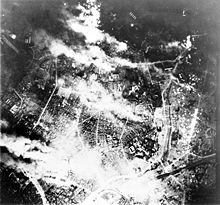






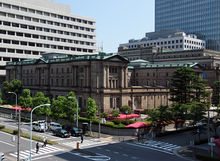



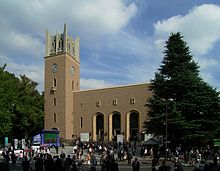













No comments:
Post a Comment